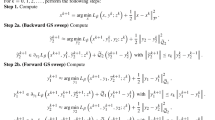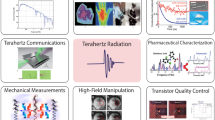Abstract
We propose a robust autofocus method for reconstructing digital holograms and twin-image removal based on blind source separation approach. The method is made up of two components: an efficient quincunx lifting scheme based on wavelet packet transform, whose role is to maximize a sharpness metric related to the sparseness of the input holograms, and a geometric unmixing algorithm, which achieves the separation task. Experimental results confirm the ability of sparse blind source separation to discard the unwanted twin-image from in-line digital holograms of particles.







Similar content being viewed by others
References
Gabor, D.: A new microscopic principle. Nature 161, 777–778 (1948)
Leith, E.N., Upatnieks, J.: Reconstructed wavefronts and communication theory. J. Opt. Soc. Am. 52, 1123–1130 (1962)
Onural, L.: Diffraction from a wavelet point of view. Opt. Lett. 18, 846–848 (1993)
Belaid, S., Lebrun, D., Ozkul, C.: Application of two dimensional wavelet transform to hologram analysis: visualization of glass fibers in a turbulent flame. Opt. Eng. 36, 1947–1951 (1997)
Kreis, T.M.: Handbook of Holographic Interferometry. Wiley, Colorado (2005)
Schnars, U., Juptner, W.P.O.: Digital Holography. Springer, Berlin (2004)
Coetmellec, S., Lebrun, D., Ozkul, C.: Characterization of diffraction patterns directly from in-line holograms with the fractional Fourier Transform. App. Optics 41, 312–319 (2002)
Xu, W., Jericho, M.H., Kreuzer, H.J.: Tracking particles if four dimensions with in-line holographic microscopy. Opt. Lett. 28, 164–166 (2003)
Bragg, W., Roger, G.: Elimination of the unwanted image in diffraction microscopy. Nature 167, 190 (1951)
Leith, E., Upatnieks, J.: Wavefront reconstruction with continuous-tone objects. J. Opt. Soc. Am. 53, 13771381 (1963)
Cuche, E., Marquet, P., Depeursinge, C.: Spatial filtering for zero-order and twin-image elimination in digital off-axis holography. Appl. Opt. 39, 40704075 (2000)
Yamaguchi, I., Zhang, T.: Phase-shifting digital holography. Opt. Lett. 22, 1268 (1997)
Onural, L., Scott, P.: Digital decoding of in-line holograms. Opt. Eng. 26, 11241132 (1987)
Latychevskaia, T., Fink, H.: Solution to the twin image problem in holography. Phys. Rev. Lett. 98, 23390 (2007)
Denis, L., Fournier, C., Fournel, T., Ducottet, C.: Twin-image noise reduction by phase retrieval in in-line digital holography. Proc. SPIE 5914, 59140J1 (2007)
Pedrini, J., Frning, P., Fessler, H., Tiziani, H.: In-line digital holographic interferometry. Appl. Opt. 37, 62626269 (1998)
Hattay, J., Belaid, S., Naanaa, W.: Geometric blind source separation using adaptive lifting scheme. In: 17th IEEE SPA conference SPA’2013 Spetember 2013 Poland
Naanaa, Wady, Nuzillard, Jean-Marc: A geometric approach to blind separation of nonnegative and dependent source signals. Signal Process. 92(11), 2775–2784 (2012)
Slimani, F., Grhan, G., Gouesbet, G., Allano, D.: Near-field Lorenz–Mie theory and its application to microholography. App. Optics 23(22), 4140–4148 (1984)
Khosravy, M., Asharif, M.R., Yamashita, K.: A theoretical discussion on the foundation of Stones blind source separation. Signal, Image and Video Process. 5(3), 379–388 (2011)
Amari, S. I., Cichocki, A., Yang, H.H.: A new learning algorithm for blind source separation, Advances in Neural Information Processing Systems 8, pp. 757–763, MIT Press (1996)
Hyvarinen, A., Karhunen, J., Oja, E.: Independent Component Analysis. Wiley, Colorado (2001)
Han, X.-H., Chen, Y.-W.: A robust method based on ICA and mixture sparsity for edge detection in medical images. Signal, Image and Video Process. 5(1), 39–47 (2011)
Hyvarinen, A., Oja, E.: A fast fixed-point algorithm for independent component analysis. Neural Comput. 9(7), 1483–1492 (1997)
Chan, T.-H., Ma, W.-K., Chi, C.-Y., Wang, Y.: A convex analysis framework for blind separation of non-negative sources. IEEE Trans. Signal Process. 56, 5120–5134 (2008)
Li, X., Cui, J., Zhao, L.: Blind nonlinear hyperspectral unmixing based on constrained kernel nonnegative matrix factorization. Signal, Image and Video Process. (2012). doi:10.1007/s11760-012-0392-3
Ma, L., Tsoi, A.C.: A unified balanced approach to multichannel blind deconvolution. Signal, Image and Video Process. 1(4), 369–384 (2007)
Smaragdis, P.: Blind separation of convolved mixtures in frequency domain. Neurocomputing 22, 21–34 (1998)
Mitianoudis, N., Davies, M.: New fixed-point ICA algorithm for convolved mixtures. In: Proceedings of the 3rd International Workshop on Independent Component Analysis and Blind Source Separation, San Diego, California, pp. 633–638 (2001)
Zibulevsky, M., Pearlmutter, B. A., Bofill, P., Kisilev, P.: Blind Source Separation by Sparse Decomposition, chapter in the book: S. J. Roberts, and R.M. Everson (eds.), Independent Component Analysis: Principles and Practice, Cambridge (2001)
Calderbank, A.R., Daubechies, I., Sweldens, W., Yeo, B.-L.: Wavelet transforms that map integers to integers. Appl. Comput. Harmonic Anal. 5, 332–369 (1998)
Hattay, J., Benazza-Benyahia, A., Pesquet, J.-C.: Adaptive lifting for multicomponent image coding through quadtree partitioning. In: Proc. of the IEEE Int. Conf. on Acoustics, Speech, Signal Processing, Philadelphia, USA (2005)
Benazza-Benyahia, A., Pesquet, J.-C., Hattay, J., Masmoudi, H.: Blockbased adaptive vector lifting schemes for multichannel image coding. Eurasip Int. J. Image and Video Process. (IJIVP) 2007(1) (2007) article ID 13421, p. 10
Motzkin, T., Raiffa, H., Thompson, G., Thrall, R.J.: The Double Description Method. Annals of Math Studies, 8, pp. 51–73. Princeton University Press, Princeton (1953)
Cochran, D., Gish, H., Sinno, D.: A geometric approach to multiple-channel signal detection. IEEE Trans. on Signal Process. 43(9), 2049–2057 (1995)
Donoho, D.: Denoising by soft thresholding. IEEE Trans. Inf. Theory 41(3), 613–627 (1995)
Lebrun, D., Allano, D., Ms, L., Walle, F., Corbin, F., Boucheron, R., Frchou, D.: Size measurement of bubbles in a cavitation tunnel by digital in-line holography App. Optics 50(34), H1–H9 (2011)
Author information
Authors and Affiliations
Corresponding author
Rights and permissions
About this article
Cite this article
Hattay, J., Belaid, S., Lebrun, D. et al. Digital in-line particle holography: twin-image suppression using sparse blind source separation. SIViP 9, 1767–1774 (2015). https://doi.org/10.1007/s11760-014-0646-3
Received:
Revised:
Accepted:
Published:
Issue Date:
DOI: https://doi.org/10.1007/s11760-014-0646-3




